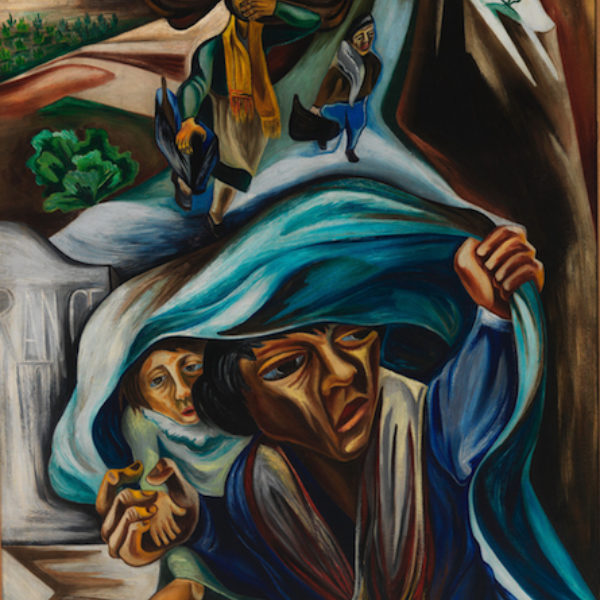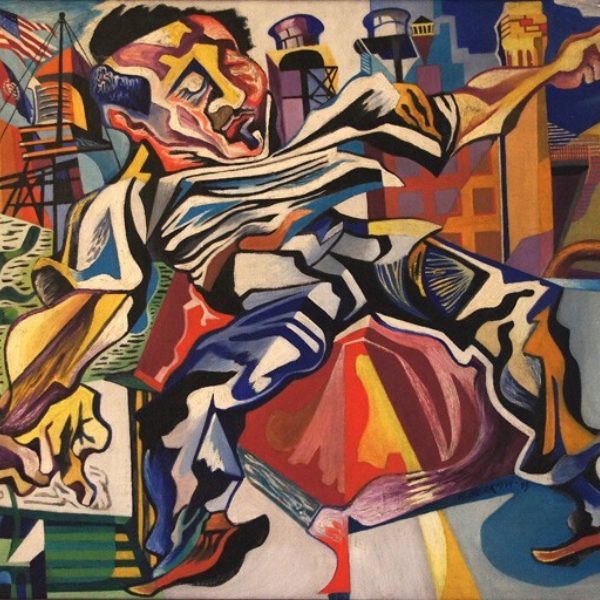Bernece Berkman
b. 1911, Chicago, IL - d. 1988, New York, NY
Bernece Berkman was born in Chicago in 1911, according to a typescript biography (1938) in the Ryerson Library at the Art Institute of Chicago, to an American born mother and a Russian immigrant father. Other sources date her birth to 1910. She studied briefly at the School of the Art Institute of Chicago (SAIC) beginning in 1927 until she ran out of money; she subsequently took evening sketching classes in Todros Geller’s studio and by 1932 was also working in oils under his guidance. Berkman shared Geller’s interest in Jewish themes combined with issues of social justice, and works such as Jews Fleeing War (1939) used the means developed by modernist artists to express her deeply held ideas. And like Geller, Berkman’s commitment to social justice stemmed from the Jewish commandment of tikkun olam, repair of the world. Although Geller was a committed modernist, Berkman’s experience with another mentor, Rudolph Weisenborn, helped her to develop the cubist/expressionist style that characterizes the work she produced in Chicago in the prewar period. (Like many artists whose careers spanned the war, her style and subject matter changed considerably after 1945; she also moved to New York in 1946.)
Berkman exhibited publically for the first time in 1934, in a group show of Jewish artists at the Palmer House in Chicago. She continued to exhibit with Jewish groups such as Around the Palette, and at the College of Jewish Studies (now the Spertus Institute of Jewish Studies), where she had a solo exhibit in 1936; with artists’ groups such as the Chicago Society of Artists; at the Art Institute annuals; and with more radical groups such as the American Artists Congress and the Artists Union. She worked on both the painting and printmaking programs of the Illinois Art Project of the WPA in the 1930s. Printmaking, in particular, allowed her the freedom to experiment with radical style, Jewish themes, and socially committed subject matter. In her contribution to the folio of woodcuts A Gift to Birobidjan (1937), Toward a Newer Life, she used the biblical exodus as a metaphor for the freedom offered by the Jewish homeland the Soviets were hoping to establish in Birobidjan, and combined references to building the pyramids with working in a modern industrial city. Going beyond the stylistic innovations of Weisenborn’s cubist-based modernism, Berkman flattened shapes, introduced extreme distortions of size, and referred to Picasso’s recently completed Guernica in the central figure with upraised arms.
Berkman’s stylistic innovation and uncompromising commitment to the powerless in society were central to her work. In both Jews Fleeing War and Untitled (Man in the City), her expressionism may seem almost excessive. It can be seen, however, as essential to her vision of the artist as a worker contributing to the cause of justice, using the means at her disposal in the strongest way possible.
Berkman married Oscar Hunter, an African American writer, in 1946. They lived and worked in New York, running a successful wallpaper company together, Berk-Hunter Associates, until 1970. They divorced in 1976. Berkman’s death, as a squatter in a studio in New York with no heirs, is a sad coda to a distinguished career.
Susan Weininger
References
Berkman, Bernece. Pamphlet file P-02921. Ryerson Library. Art Institute of Chicago. [1 item]
Berkman-Hunter, Bernece, Papers. Manuscript Division. Library of Congress, Washington, DC.
Carie, Audrey E. “Bernece Berkman and the Monograph: A Feminist Perspective.” Master’s thesis, DePaul University, 2011.
Weininger, Susan. “Bernece Berkman.” In Elizabeth Kennedy, ed. Chicago Modern, 1893–1945: The Pursuit of the New, 91. Exh. cat. Chicago: Terra Foundation for the Arts, 2004.

